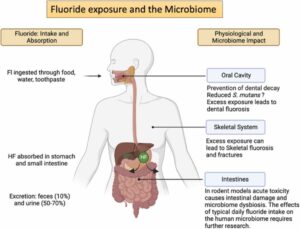In a recent study published in the journal Toxicology Letters, researchers discuss the effect(s) of fluoride exposure on the human microbiome.

The toxicology of fluoride
Community water fluoridation (CWF) significantly improves oral health by decreasing the prevalence of caries. The World Health Organization (WHO) recommends 1 mg/L of sodium fluoride in water for good oral health.
However, chronic exposure to high concentrations can result in dental fluorosis. Skeletal fluorosis is reported in areas with high fluoride levels in groundwater and can cause damage to the joints and bones. Fluoride can also cause tissue damage and exert toxic effects at extremely high concentrations.
Given its toxicity concerns, research efforts are currently investigating the impact of CWF on health. Systematic reviews have found no convincing evidence for the long-term effects of fluoridation at WHO-recommended concentrations in humans.
In the present study, researchers review previous publications to evaluate how fluoride exposure affects the human microbiome.
Fluoride exposure and the microbiome
A healthy microbiome in the oral cavity is essential to prevent periodontal disease and dental caries. It is speculated that fluoride can disrupt the homeostasis between humans and the microbiome.
The microbiome in the gastrointestinal (GI) tract remains exposed to fluoride after drinking fluoridated water. The oral cavity is likely the most exposed to fluoride, as it is the first exposure point.
Fluoride accumulation in dental plaque is well established in people using fluoride dentifrices; however, data on fluoride levels in the mid/lower GI tract are scarce.
Fluoride absorption into tissues increases down the GI tract, with 40% absorbed in the stomach and the remaining in the small intestine. Nearly 10% of fluoride is excreted in feces, thus suggesting all GI tract regions are exposed to fluoride.
Fluoride exhibits antifungal and antibacterial activity and has been shown in vitro to inhibit bacterial growth that may result from enzyme inhibition or acidification of the cytoplasm. Much research has been centered around the effects of fluoride on Streptococcus mutans, a species involved in caries development, with several reports suggesting that acid tolerance is pivotal for its survival in acidic caries.
Effects of fluoride exposure on the microbiome in humans and animals
The researchers performed a literature search using relevant terms on Scopus and PubMed databases. They identified 190 articles published between 1986 and 2022, 41 of which were selected for the final analysis after exclusions were applied. Most human studies examined the effects of fluoride dentifrices, mouthwashes, and varnishes on the oral microbiome.
Several studies found no or limited effects on the oral microbiome, with some suggesting benefits. A few studies examining the impact of silver diamine fluoride on the oral microbiome in caries treatment reported minor plaque microbiome changes in the intervention arm. Likewise, different research groups have studied stannous and fluoride (F/Sn)-containing products.
In general, using F/Sn-containing toothpaste might decrease cariogenic bacteria; however, larger studies are required to corroborate this finding.
Only one study from China analyzed the potential effects of excessive fluoride exposure from drinking water. This study revealed significant changes in the oral microbiome, which included lower Bacteroidetes and higher Firmicutes levels, of children with moderate/severe fluorosis, albeit its significance from a health perspective was unknown.
Among animal studies, many have explored the effects of fluoride on the microbiome. Most studies focused on acute fluoride toxicity and only one assessed the impact of prolonged exposure to low fluoride concentrations.
Rats ingesting water with 50 mg/L fluoride for 30 days exhibited inflamed ileum and gut microbiome alterations. Increasing fluoride concentrations to 100 mg/L caused more extensive changes in the cecum, with reductions in Firmicutes and elevations in Bacteroidetes.
More research is needed to determine if such changes to the gut microbiota also occur in humans exposed to fluoride at recommended concentrations. Besides fluoride, arsenic is present in water in some regions. Mice exposed to 100 mg/L fluoride, 50 mg/L arsenic, or both exhibit cardiovascular defects and gut microbiome changes.
Concluding remarks
Precious studies on the oral microbiome suggest that topical fluoride use has little impact and, rather, may be beneficial. However, exposure to fluoride in water at higher concentrations might have a much more severe effect on the oral microbiome.
Animal studies suggest significant changes in the gut and oral microbiomes due to fluoride exposure. Overall, population-based studies are required to determine how CWF and fluoride exposure affects the human microbiome.
*Original full-text article online at: https://www.news-medical.net/news/20230307/Does-ingested-fluoride-affect-the-human-microbiome.aspx
